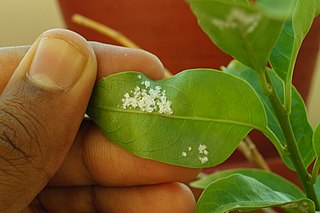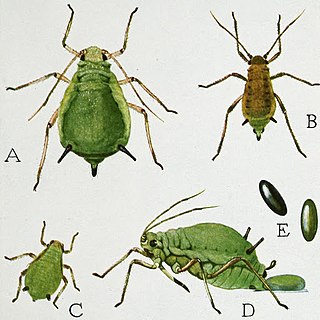Related Research Articles

Woolly aphids are sucking insects that live on plant sap and produce a filamentous waxy white covering which resembles cotton or wool. The adults are winged and move to new locations where they lay egg masses. The nymphs often form large cottony masses on twigs, for protection from predators.

Skimmia is a genus of four species of evergreen shrubs and small trees in the Rue family, Rutaceae, all native to warm temperate regions of Asia. The leaves are clustered at the ends of the shoots, simple, lanceolate, 6–21 cm long and 2–5 cm broad, with a smooth margin. The flowers are in dense panicle clusters, each flower small, 6–15 mm diameter, with 4-7 petals. The fruit is red to black, 6–12 mm diameter, a fleshy drupe containing a single seed. All parts of the plant have a pungent aroma when crushed. The botanical name, Skimmia, is a Latinization of shikimi, which is the Japanese name for Illicium religiosum as well as an element in miyama shikimi, the Japanese name for Skimmia japonica.

The American Elm cultivar Ulmus americana 'New Harmony' was raised by the Maryland Agricultural Research Service and released by the United States National Arboretum in 1995, along with 'Valley Forge'. 'New Harmony' proved the most successful U. americana cultivar in the US National Elm Trial, averaging a survival rate of 85.5% overall.

Japonica rice, sometimes called sinica rice, is one of the two major domestic varieties of Asian rice. Japonica rice is extensively cultivated and consumed in China, Japan, and Korea, whereas in most other regions indica rice is the dominant type of rice. Japonica rice originated from Central China, where it was first domesticated along the Yangtze River basin approximately 9,500 to 6,000 years ago.

Watermelon mosaic virus (WMV) also known as Marrow mosaic virus, Melon mosaic virus, and until recently Watermelon mosaic virus type 2 (WMV-2), is a plant pathogenic virus that causes viral infection in many different plants. First described on squash in Florida, WMV arose from a unique recombination of genetic material contributed by Soybean mosaic virus (SMV) and Bean common mosaic virus (BCMV) along with Peanut Stripe virus (PSV).

Phylloxeridae is a small family of plant-parasitic hemipterans closely related to aphids with only 75 described species. This group comprises two subfamilies and 11 genera with one that is fossil. The genus type is Phylloxera. The Phylloxeridae species are usually called Phylloxerans or Phylloxerids.

Chaetosiphon fragaefolii, the strawberry aphid, is a bug species in the genus Chaetosiphon found in the United States (Arizona), Argentina and Chile.
The Sugarcane Woolly Aphid,, is an aphid in the superfamily Aphidoidea in the order Hemiptera. It is a true bug and sucks sap from plants. It is a foliage sucking aphid species.
Kaltenbachiella elsholtriae, is an aphid in the superfamily Aphidoidea in the order Hemiptera. It is a true bug and sucks sap from plants.
Tetraneura yezoensis, also known as Tetraneura (Tetraneura) yezoensis, is an aphid in the superfamily Aphidoidea in the order Hemiptera. It is a true bug and sucks sap from plants.
Amphritea japonica is a Gram-negative, rod-shaped, non-spore-forming and motile bacterium from the genus of Amphritea which has been isolated from sediments near a sperm whale carcasses from Kagoshima on Japan.
Marinobacterium rhizophilum is a Gram-negative and strictly aerobic bacterium from the genus of Marinobacterium which has been isolated from sediments near the roots of the plant Suaeda japonica from Eulwangri beach in Korea.
Tetrasphaera japonica is a Gram-positive bacterium species from the genus of Tetrasphaera which has been isolated from activated sludge from Japan.
Dyella japonica is a Gram-negative, aerobic and rod-shaped bacterium from the genus of Dyella which has been isolated from soil from a garden in Tokyo in Japan.
Rheinheimera japonica is a Gram-negative, rod-shaped, aerobic and motile bacterium from the genus of Rheinheimera which has been isolated from seashore sediments from the Sea of Japan in Russia. Rheinheimera japonica has an antimicrobial activity.
Kaltenbachiella pallida is a species of true bug belonging to the family Aphididae.
References
- http://animaldiversity.org/accounts/Kaltenbachiella_japonica/classification/
- http://www.nbair.res.in/Aphids/Kaltenbachiella-japonica.php
- http://aphid.speciesfile.org/Common/basic/Taxa.aspx?TaxonNameID=1161173
- https://www.uniprot.org/uniprot/A0A096VK42
| | This article related to members of the insect family Aphididae is a stub. You can help Wikipedia by expanding it. |